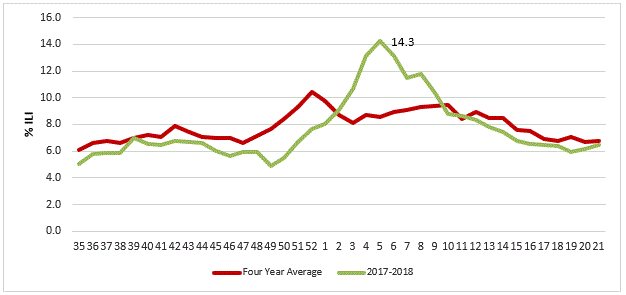Influenza
Monitoring Influenza in Kent County
In General
In the beginning of the 20th century, infectious diseases were the leading cause of death worldwide. During the 1918 influenza pandemic, 20 million deaths occurred with 500,000 of those deaths in the United States. Due to public health achievements such as sanitation and hygiene, the use of vaccinations, and the discovery of antibiotics, many diseases that once affected the United States, such as cholera, yellow fever, and tuberculosis, are no longer an issue. Currently, the only infectious diseases on the list of leading causes of death in the U.S. are influenza and pneumonia, which together cause nearly 60,000 deaths per year. In Kent County, there were 85 deaths in 2016 from influenza or pneumonia; 84 percent of these deaths occurred in the population 65 years of age and older. Influenza/pneumonia was the 7th most common cause of death in Kent County in 2016.
It is difficult to estimate an average number of influenza deaths per year because the number varies, but within the past four decades, flu-associated deaths have ranged between 12,000 and 56,000 annually. Influenza is an infectious respiratory illness which can range from mild to severe. There are three categories of individuals who are at high-risk for serious flu complications; older people, younger children, and people with certain health conditions. Receiving an annual influenza vaccine is the most effective way to prevent infection, especially among those in the high-risk categories.
Last Year
Data from the Michigan Syndromic Surveillance System are useful in providing an indication of local influenza-like illness (ILI) activity. The percentage of people visiting local emergency departments each week for ILI are compared to data from the previous four seasons to indicate how the current season’s activity compares to what is “expected” during each week (Figure 1). During the 2017-2018 season, activity peaked during the week ending February 3, 2018 (MMWR Week 5) when 14.3% of emergency departments in the county were for ILI. Peak influenza activity occurred about two weeks earlier than during the 2016-2017 season, when activity was highest during the week ending February 18, 2017. The peak level of emergency department visits in 2017-2018 was greater than the 11.5% that was observed during peak activity in 2016-2017.
According to the CDC, influenza activity was more severe overall in 2017-2018 compared to the previous season. CDC deemed 2017-2018 as a high severity season with high levels of outpatient clinic and emergency department visits for ILI, high influenza-related hospitalization rates, and elevated and geographically widespread influenza activity for an extended period. Overall, influenza A (H3N2) was the predominant circulating strain, however, influenza B viruses became more commonly reported than influenza A viruses in early March 2018 through May 2018. Most circulating viruses were determined to be well-matched to the components of the 2017–18 influenza vaccine and the overall vaccine effectiveness was estimated to be 40%.
Figure 1. Percentage of Patients Presenting to Kent County Emergency Departments with Complaints of Influenza-like Illness (ILI), 2017-2018 Influenza Season compared to the 4-year average

This Year
Although it is impossible to predict how this year’s influenza season will compare to last year’s, the Kent County Health Department will continue using its three-part comprehensive plan that will focus on surveillance, prevention/control of influenza, and public education.
The Epidemiology unit is responsible for conducting effective and timely influenza surveillance in Kent County. This entails collecting, analyzing, interpreting, and disseminating influenza data. Epidemiologists study the frequency, pattern and causes of influenza and influenza outbreaks in the Kent County population. They ask and try to answer the “who, what, when, where, why, and how” questions.
Surveillance
There are three main goals of influenza surveillance:
- To provide epidemiologic information during the annual influenza season to measure the development and seriousness of each influenza season;
- To monitor changes in circulating viruses;
- Determine the magnitude of influenza illness in the county in order to guide the actions of county public health officials.
KCHD monitors influenza in several ways:
- Physician reports of influenza- Influenza is an officially reportable condition that is required by state law to be reported to the KCHD.
- Laboratory reports of influenza- Influenza is also a state mandated reportable disease. Labs are required by law to report confirmed results to the local health department
- Infection Control Departments - The KCHD has requested that local hospital Infection Control Departments report confirmed cases of influenza to the KCHD.
- Daycares, schools and camps - are required by law to report the weekly total number of cases of influenza to the KCHD.
- “Sentinel” providers - physicians who have agreed to report cases of “influenza-like” illness visits by age group, and the total number of “influenza-like” visits per week
- Emergency Departments – KCHD has access to chief complaint data from Kent County emergency departments, which allows for tracking of patients visiting the EDs for influenza-like symptoms.
The Kent County Health Department also monitors influenza activity at the state, national, and global levels. Information that is collected in Kent County is reported to the state health department. The data is then forwarded on to the CDC.
Data collection, analysis, interpretation, and dissemination
Following the receipt of confirmed cases of influenza from labs, physicians, and hospital infection control departments, the data will be entered into a database. From October through May, surveillance information will be updated weekly. Aggregate data on confirmed cases and school reporting data will be available on the Kent County
Health Department’s influenza website. An epidemiologist will analyze and interpret data and determine how the data relates to trends seen at the state and national levels.
Information For Health Care Providers
Conclusion
While no intervention is likely to eradicate influenza, the KCHD’s plan provides a comprehensive methodology for educating and informing the public about the prevention/control of influenza in Kent County. This plan was developed as a tool for guiding individual and community actions in order to reduce the risk of influenza.